Cognitive Distortions 101
What are fun mirror thoughts and how to fight back
MENTAL HEALTH TOOLSANXIETYEMOTIONSQUIZZES
What are fun mirror thoughts?
Not all mirrors are created equal. Some have a slight distortion in them (1 or 2 percent), while others have more distortions ( like funhouse mirrors ). Our thoughts are like mirrors. They reflect our reality back to us. When they are balanced and healthy, they offer very little distortions, helping us feel emotionally balanced. But when they are unbalanced and overtly negative, they become like fun mirrors-- distorted and exaggerated. However, we perceive them to be an accurate reflection of our reality which results in emotional distress, sadness, and anxiety.
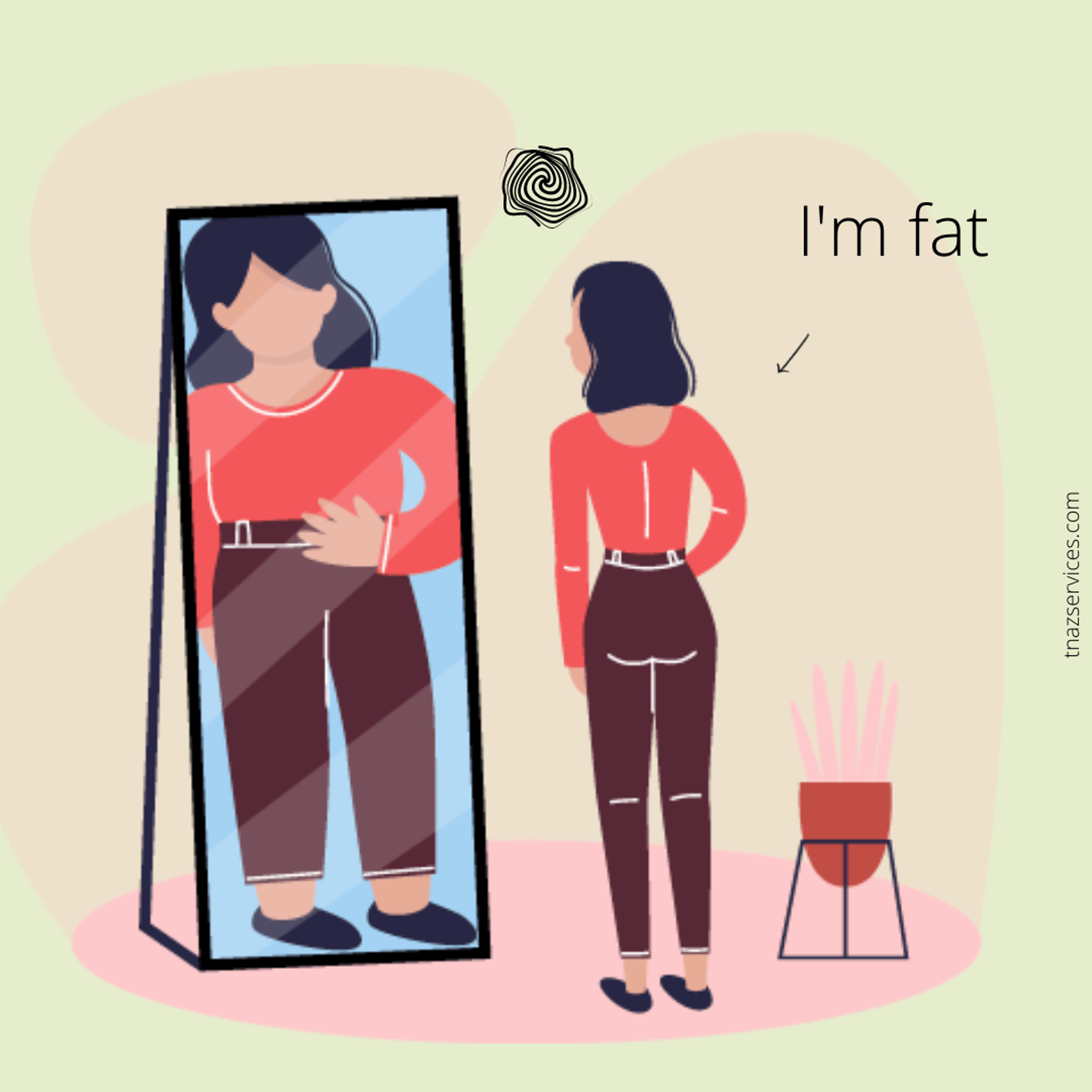
What Makes Cognitive distortions dangerous?
In the world of therapy, we call fun-mirror thoughts cognitive distortions (a distortion within our thinking process). Cognitive distortions are super dangerous because they influence our happiness and behavior, thereby destroying our relationships and lives. We become enslaved to these thoughts if they are left unchallenged or unchecked for long periods of time. Eventually they become automatic and persistent as they dominate all other reasonable thoughts. They become ruminations. Below are examples of the types of distortions that we all experience to some degree, but when exaggerated, becomes concerning.
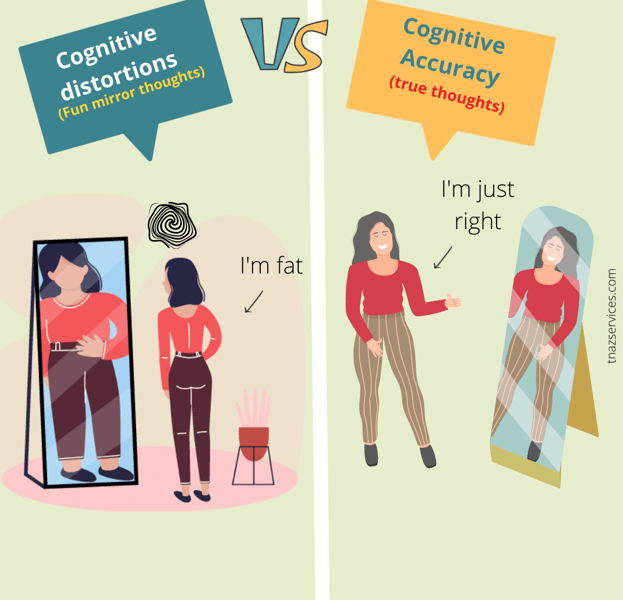


Pre- Study Exercise
Below are some examples of cognitive distortions, depicted through pictures. Take a moment to guess what each picture is trying to convey about the meaning of that cognitive distortion
1
Jumping to conclusions
Jumping to conclusions is making rash judgments about a situation based on little to no evidence. There are two types: Mind reading and predictive thinking.
Mind reading is assuming we know what others are thinking without any concrete evidence to support your assumption. For instance, if someone assumes that a friend is angry with them without any clear indication of this emotion, they are engaging in mind reading.
Predictive Thinking: This involves making assumptions about future outcomes or judging past events based on minimal evidence. For example, if someone concludes that a party will be boring and decides not to attend without having any solid information about the event, they are using predictive thinking.
Worst Case Scenario/Catastrophizing:
Worst case scenario or catastrophizing is a cognitive distortion that involves imagining the most negative or disastrous outcome of a situation. For example, if you have a minor disagreement with your partner, you might think that they will break up with you, or if you make a mistake at work, you might think that you will get fired.
Another example is if you have a headache, you might think that you have a brain tumor, or if you are late for a meeting, you might think that you will lose your client.
All types of jumping to conclusions can lead to misunderstandings, miscommunications, and poor decision-making. It's important to gather sufficient information and consider various perspectives before making judgments or assumptions about people, situations, or outcomes.
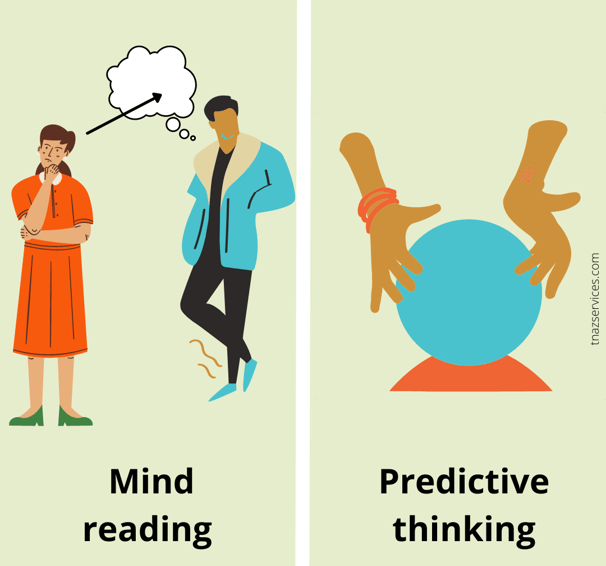

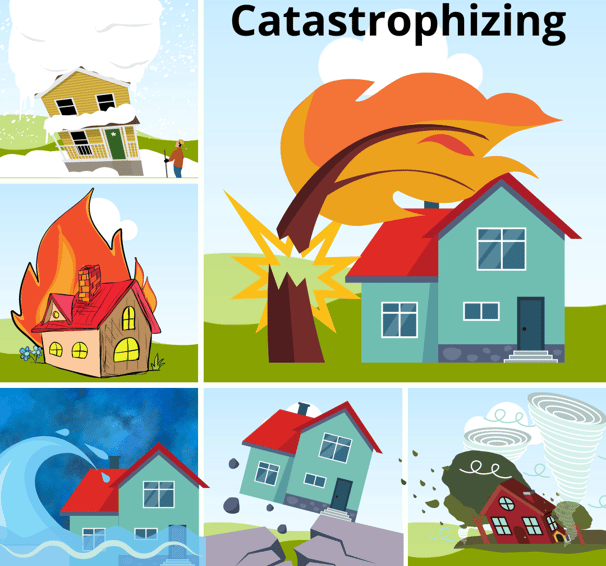

2
Emotional Reasoning
Emotional reasoning is a cognitive distortion where an individual evaluates and interprets situations primarily through their current emotions. Instead of objectively assessing facts or evidence, they rely on their feelings as the basis for their conclusions.
a. Assessing situations through the lens of our current emotions:
Emotional reasoning involves using one's emotional state to determine the validity of thoughts or beliefs. For example, if someone is feeling anxious, they might interpret neutral events as threatening.
b. Analogy: Emotional self taking over the driver's seat:
Just like a driver who lets their emotional side control the car despite evidence that it's leading them into danger, emotional reasoning involves letting emotions guide thoughts even when those thoughts might not be accurate.
c. Interpreting a situation solely based on current feelings:
This point underscores that emotional reasoning involves looking at a situation exclusively through the emotional lens, ignoring other perspectives or evidence. This can lead to biased and distorted conclusions.
Examples of emotional reasoning:
"Because I feel a certain way, my thoughts must be true": This statement illustrates the tendency to equate emotions with objective reality, assuming that if a feeling is strong, it must reflect an accurate assessment of a situation.
- "I feel like a failure, therefore I am a failure": This example demonstrates the jump from an emotional state to an all-encompassing negative self-evaluation, without considering other factors that might contribute to feelings of failure.
- "I feel like it's all my fault, therefore it must be my fault": Here, emotions drive the assumption of blame, even if there might be external factors at play that contribute to the situation.
Recognizing emotional reasoning and challenging these kinds of thought patterns is crucial for maintaining balanced and rational thinking. It's important to examine the evidence, consider alternative viewpoints, and avoid letting emotions cloud one's judgment.
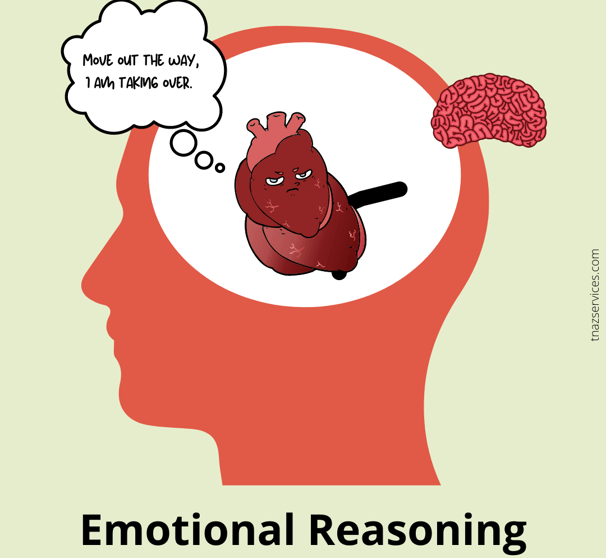

3
Should & Aught To
Using critical words like "should," "must," or "ought":
These words often carry a sense of obligation or expectation, creating a standard that must be met. When we apply them to ourselves or others, it can lead to feelings of guilt, failure, and disappointment if those expectations are not fulfilled.
The impact of forming expectations:
By using such critical words, we set up rigid expectations that can be challenging to meet. When reality doesn't align with these expectations, it can result in feelings of frustration, self-blame, and disillusionment.
Alternative phrasing suggestions:
Below are suggested alternatives that offer a more flexible and compassionate way of approaching situations:
a. "It would have been nice if...": This phrasing acknowledges a desire without imposing a strict requirement. It allows for a sense of hope without the weight of expectation.
b. "I would be really happy if I am able to...": This alternative links happiness to the achievement of a goal while recognizing that it's not an absolute necessity.
c. "It is my intention to...": This phrasing emphasizes intent rather than obligation. It conveys a willingness to work towards a goal without dictating a specific outcome.
d. "It would be great to be able to...": This approach maintains enthusiasm for a desired outcome without making it imperative.
e. "I will try my very best to...": This wording implies effort and commitment without guaranteeing a particular result. It emphasizes the process rather than the outcome.
f. "I sincerely hope that I can...": This phrasing shows genuine aspiration while allowing for the possibility that circumstances might not align as expected.
Use the swap and replace method for addressing should statements
Consider replacing "should" or any critical words to words such as " I need to or I have to" with words that fuel expectations, desire, and eagerness such as "I get to or I want to". For example, Instead of "I need to, do work out tomorrow", consider saying, " I want to show my body appreciation and love through healthy habits. I want to feel good about myself when I look into the mirror, I get to feel accomplished after I work out". Another example is, Instead of saying, " I have to go to work tomorrow", consider saying I get to make money and live a comfortable life...I get to provide for my family...I get to make an impact at work... etc".
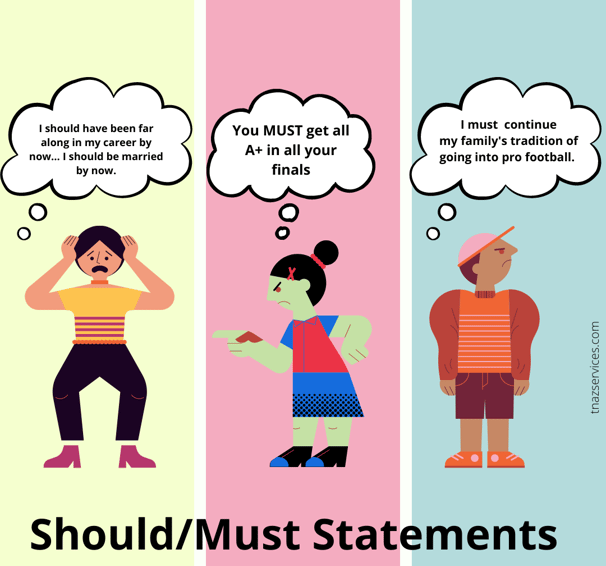

4
Magnification & Minimization
Magnification (Catastrophizing):
Magnification involves blowing situations out of proportion, making them seem much more significant, dire, or threatening than they really are. This distortion can lead to excessive worry, anxiety, and stress. People who engage in catastrophizing often imagine the worst-case scenarios and dwell on potential negative outcomes.
Minimization:
Minimization is the opposite of magnification. It involves downplaying the significance of a situation, often inappropriately. This distortion might lead someone to dismiss their accomplishments, ignore their positive qualities, or overlook potential consequences. Minimization can prevent individuals from recognizing their achievements or addressing important issues.
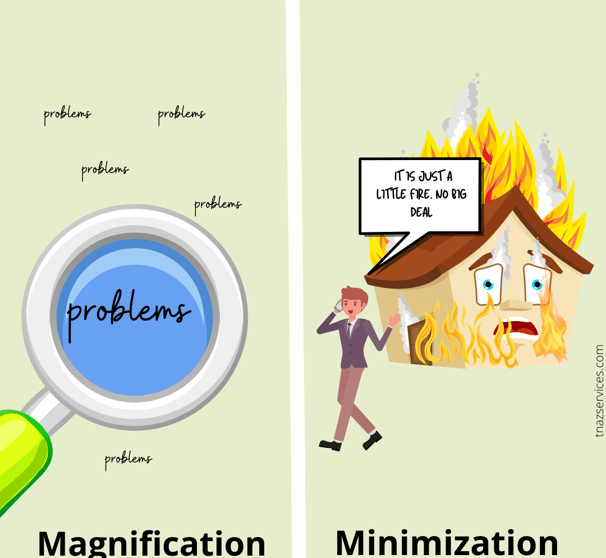

5
Labeling
Defining with Negative Labels: This distortion involves assigning negative labels to oneself or others based on a single event, perceived behavior, or characteristic. These labels are often overly general and can lead to biased and unfair judgments. This disregards the complexity of human behavior and the potential for growth and change.
Examples of Labeling:
Self-Labeling:
"I'm so clumsy. I dropped my phone again."
"I'm terrible at public speaking. I stuttered during my presentation."
Labeling Others:
"He's a total slacker. He missed one deadline."
"She's such a drama queen. She got emotional during the meeting."
Social Situations:
"They didn't invite me to the party because they think I'm boring."
"Nobody laughed at my joke. I must be really unfunny."
Impact on Perception:
Habitual labeling can lead to a cognitive distortion known as "mental filtering." This means that, when we habitually label ourselves or others in negative ways, we start to selectively focus on and amplify those negative aspects while ignoring or downplaying positive qualities or experiences.
Effects of Labeling:
Labeling can hinder personal growth, damage self-esteem, strain relationships, and contribute to a negative cycle of thoughts and emotions. It often oversimplifies complex situations and prevents us from seeing the full picture.
Recognizing when we engage in labeling and learning to challenge these negative and overly simplistic judgments is important for maintaining a more balanced and compassionate perspective on ourselves and others. It allows us to see individuals as multifaceted and capable of change, rather than reducing them to a single label based on limited information.
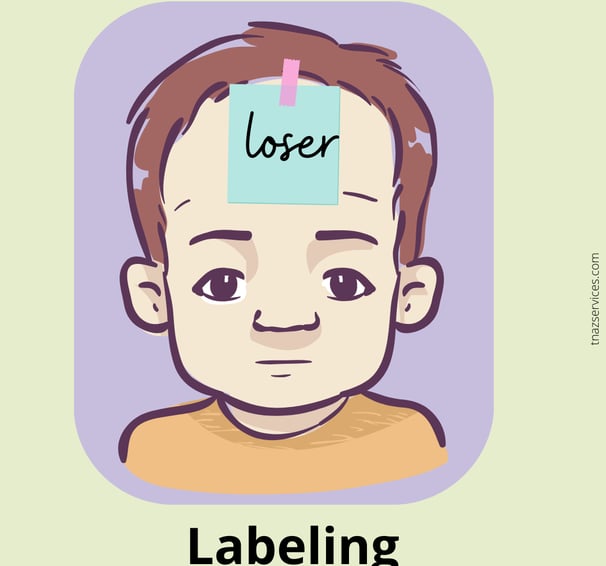

More Examples of Labeling:
Academic Performance:
"I failed one test. I'm just not smart enough for this class."
"She got the highest score. She's the genius of our group."
Physical Appearance:
"I gained a few pounds. I'm so fat."
"He has acne. He's ugly."
Workplace Scenarios:
"I made a mistake in the report. I'm a failure at my job."
"He disagreed with my idea. He's always trying to undermine me."
Relationships:
"She canceled our plans. She's so unreliable."
"He forgot our anniversary. He's thoughtless and inconsiderate."
Personality Traits:
"I get nervous in social situations. I'm an introvert."
"He speaks confidently in meetings. He's an extrovert."
6.
Mental Filtering & Disqualifying The Positives
Mental Filtering:
Mental filtering involves selectively focusing on the negative aspects of a situation while disregarding or ignoring the positive aspects. It's as if you have a "filter" that only allows the negatives to be noticed, which can lead to an imbalanced and pessimistic view of reality.
Example of Mental Filtering:
If you receive many positive comments about your presentation but focus only on the one negative comment, you're engaging in mental filtering by letting that single negative aspect overshadow the overall positive feedback.
Disqualifying the Positive:
Disqualifying the positive refers to the tendency to downplay, invalidate, or dismiss positive experiences, accomplishments, or traits. This distortion involves not giving yourself credit or feeling unworthy of the positive aspects of your life.
Example of Disqualifying the Positive:
If you receive praise for a job well done and respond with "It was just luck" or "Anyone could have done it," you're disqualifying the positive by minimizing your own achievements.
Both of these cognitive distortions can contribute to negative thought patterns, self-esteem issues, and an overall distorted perception of reality. Recognizing when you're engaging in mental filtering or disqualifying the positive is a crucial step toward developing a more balanced and realistic perspective. Learning to acknowledge both positive and negative aspects of situations and yourself helps foster healthier self-esteem and a more accurate understanding of your experiences.
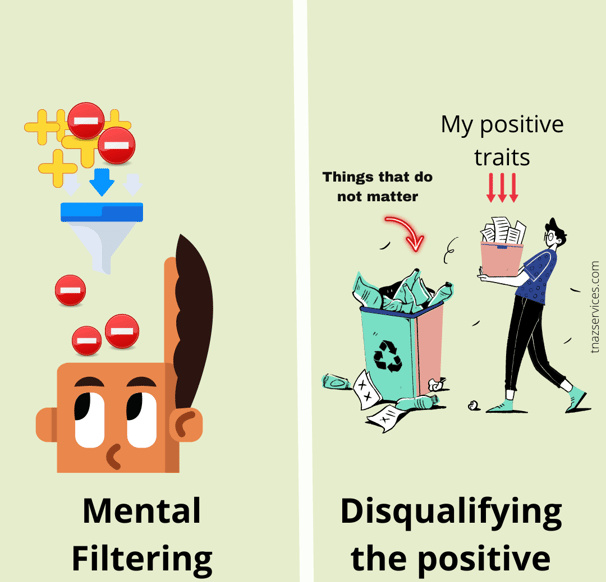

7
Black & White Thinking
Black-and-White Thinking:
Black-and-white thinking, also referred to as all-or-nothing thinking, involves perceiving situations, people, or outcomes in extreme, binary terms. There's a tendency to see things as either completely one way or completely the other, with no middle ground or nuance.
Lack of In-Between or Balanced Perspectives:
This distortion eliminates the possibility of considering shades of gray or recognizing the complexities and nuances that often exist in real life situations. It ignores the middle ground, where most experiences and truths actually reside.
Examples of Black-and-White Thinking:
Your examples effectively illustrate how black-and-white thinking can manifest:
- "People or situations are either good or bad": This example shows the tendency to categorize things as either entirely positive or entirely negative, without acknowledging that most situations and people have a mix of both qualities.
- "Life is either going really well or really bad": Here, the distortion is evident in the extreme way of assessing life events, without acknowledging the range of experiences that can fall in between these extremes.
- "You are either destined for success or for failure": This example highlights the unrealistic and polarized way of viewing personal potential, without considering that most individuals experience a combination of successes and setbacks.
- "The day is going really well or really bad": This illustrates how the distortion can even affect daily assessments, leading to an inability to recognize the variety of experiences that make up a typical day.
Recognizing black-and-white thinking is important because it can lead to undue stress, unrealistic expectations, and difficulties in problem-solving. Developing a more balanced and nuanced perspective allows for a more accurate understanding of the world and can contribute to better mental well-being.
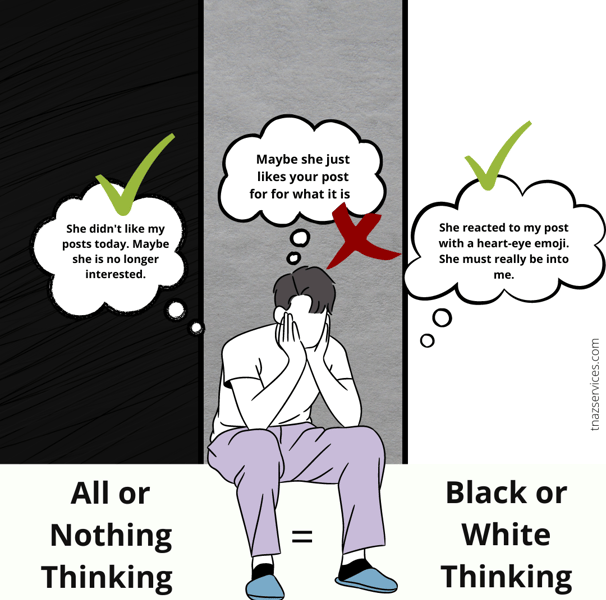

Some more examples of black-and-white thinking:
1. Relationships:
- "If they don't agree with me all the time, they're not a true friend."
- "If they make a mistake, they're a terrible partner."
2. Self-Evaluation:
- "I got one question wrong on the test. I'm a failure."
- "I didn't get the job. I'm completely unemployable."
3. Appearance:
- "I gained a little weight. I'm completely unattractive now."
- "If I don't look perfect, I'm not worthy of attention."
4. Achievements:
- "I didn't come in first place, so I might as well have not participated."
- "If I don't win, it's like I lost everything."
5. Career:
- "If I'm not promoted, I'll never have a successful career."
- "I made one mistake at work. I'm going to get fired for sure."
6. Health and Fitness:
- "I missed one workout. My entire fitness routine is ruined."
- "I had a slice of cake, so my diet is completely ruined now."
7. Emotions:
- "If I'm not always happy, there's something wrong with me."
- "Feeling sad means I'm weak and incapable."
8. Opinions:
- "If you disagree with me, you're completely wrong."
- "If you're not with us, you're against us."
8
Overgeneralization
Overgeneralization:
Overgeneralization is the process of taking a single negative event, a few occurrences, or specific instances and applying them to a much broader context. This can lead to skewed perceptions, biased judgments, and a distorted understanding of reality.
Using Absolute Words ("Always," "All," "Every"):
Using words like "always," "all," or "every" in your thinking or communication can contribute to overgeneralization. These words create an exaggerated sense of universality, implying that the negative event or pattern applies to every instance or person.
Being Overly Broad in Conclusions:
Overgeneralization involves making conclusions that are far too sweeping and fail to account for exceptions, variations, or complexities that might exist within a situation.
Examples of Overgeneralization:
Your examples aptly illustrate how overgeneralization can manifest:
- "Saying someone is always late when they were late 2 out of 10 times": This example demonstrates how using "always" creates an unrealistic perception of the individual's behavior based on a limited number of instances.
- "Saying to yourself, 'Why am I always careless,' when you've only been careless a handful of times in your life": This illustrates how overgeneralizing can lead to a negative self-definition based on isolated incidents.
- "Saying everyone from a particular group of people is violent based on one or few isolated cases": This example shows how overgeneralization can lead to unfair and prejudiced judgments about a group based on a few individuals' actions.
Recognizing overgeneralization and challenging these extreme conclusions with more balanced thinking is essential for maintaining a realistic and accurate perspective. It helps prevent us from forming unfair judgments about ourselves, others, and various situations based on limited evidence..
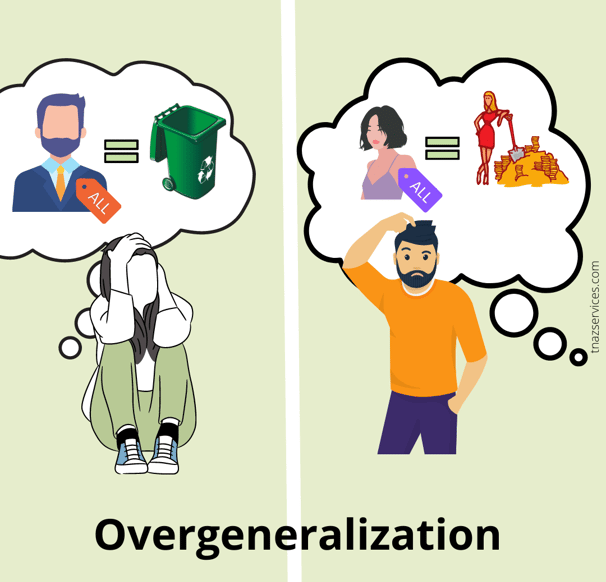

9
Personalization & Blaming
Personalization and blaming are both cognitive distortions, which are patterns of irrational thinking that can lead to negative emotions and behaviors. Let's explore each of these distortions in more detail and provide examples:
1. Personalization:
Personalization is a cognitive distortion where individuals blame themselves for events or outcomes that they have no control over, assuming they are responsible even when it is not the case. This distortion can lead to feelings of guilt, shame, and self-blame.
Examples of personalization:
- Workplace Criticism: If a colleague offers constructive criticism about a project at work, and you immediately think, "They're always picking on me; they must think I'm incompetent," you are personalizing the feedback.
- Relationships: If your partner is in a bad mood, and you assume it's because you did something wrong or that they're upset with you, even if they haven't said anything to suggest it, you are personalizing their emotions.
- Traffic Jam: Blaming yourself for getting stuck in a traffic jam, as if it's your fault for leaving home late, even though traffic conditions are beyond your control, is another example of personalization.
2. Blaming:
Blaming is a cognitive distortion where individuals assign responsibility for their problems or negative emotions to external factors or other people, avoiding personal responsibility. This distortion can hinder personal growth and problem-solving since it often overlooks one's role in a situation.
Examples of blaming:
- Procrastination: Blaming your workload, the weather, or other external factors for your procrastination instead of acknowledging your own lack of motivation or time management skills.
- Weight Gain: Blaming fast-food restaurants or your genetics for your weight gain instead of taking responsibility for your eating habits and exercise routines.
- Relationship Issues: Blaming your partner for all the problems in your relationship without considering your own contribution or communication issues.
Both personalization and blaming can be detrimental to mental health and interpersonal relationships. Recognizing these cognitive distortions and challenging them with more rational and balanced thinking can help individuals develop healthier perspectives and responses to life's challenges. Cognitive-behavioral therapy (CBT) is one approach that can be effective in addressing and modifying these distortions.
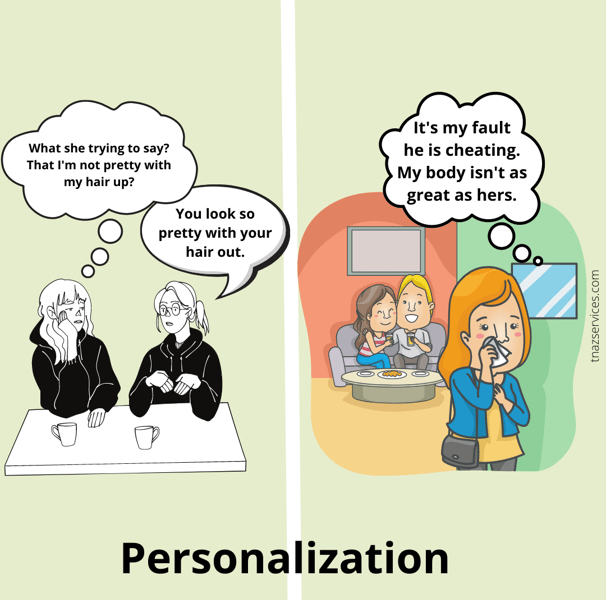

Other Less Frequent Cognitive Distortions
10
Self-Serving Bias
Self-serving bias is a cognitive bias that refers to the tendency to attribute our successes to our own abilities and efforts, while attributing our failures to external factors. This bias is often seen in everyday life, such as when we take credit for a job well done but blame others for our mistakes.
There are several reasons why we might engage in self-serving bias. One reason is that it can help us to protect our self-esteem. When we attribute our successes to our own abilities, it makes us feel good about ourselves. Conversely, attributing our failures to external factors can help us to avoid feeling like failures.
Another reason why we might engage in self-serving bias is that it can help us to maintain a positive view of ourselves. When we believe that we are capable and successful, it gives us a sense of control over our lives. This can be especially important when we are facing challenges or setbacks.
Self-serving bias can have both positive and negative consequences. On the one hand, it can help us to maintain a positive outlook and to persevere in the face of challenges. On the other hand, it can blind us to our own weaknesses and make it difficult to learn from our mistakes.
If you are concerned that you might be engaging in self-serving bias, there are a few things you can do. First, try to be more objective in your assessment of your successes and failures. Second, be mindful of the ways in which you might be attributing your successes to your own abilities and your failures to external factors. Finally, try to be open to feedback from others, even if it is negative.
Here are some examples of self-serving bias:
A student who gets an A on a test might attribute their success to their hard work and intelligence, while attributing a B to the difficulty of the test or the unfairness of the grading.
A salesperson who makes a sale might attribute their success to their own charm and persuasiveness, while attributing a lost sale to the customer's indecisiveness or lack of interest.
A politician who wins an election might attribute their victory to their strong leadership skills, while attributing their opponent's loss to their lack of experience or charisma.
Self-serving bias is a common cognitive bias that can have both positive and negative consequences. If you are concerned that you might be engaging in self-serving bias, there are a few things you can do to become more aware of it and to reduce its impact on your life.


11
Fallacies of change, control, fairness
1. Fallacy of Fairness:
The Fallacy of Fairness is a cognitive distortion where individuals believe that life should always be fair and just, and they become upset or frustrated when they perceive that things are not fair. This distorted thinking can lead to feelings of resentment, anger, and a sense of entitlement.
Examples of the Fallacy of Fairness:
- Believing that everyone should like you, and feeling hurt when someone doesn't.
- Expecting that your hard work will always be rewarded and becoming resentful when it isn't.
- Feeling that life should always be smooth and easy, and becoming frustrated when faced with challenges or adversity.
2. Fallacy of Change:
The Fallacy of Change is a cognitive distortion where individuals believe that they can change other people's behaviors, attitudes, or emotions. This thinking can lead to frustration, disappointment, and resentment when others don't change as expected.
Examples of the Fallacy of Change:
- Trying to change a friend's personality or habits to better suit your preferences, even if they are not interested in changing.
- Believing that you can make someone love you or treat you differently through your actions or efforts.
- Attempting to change a family member's political beliefs, religious views, or lifestyle choices against their will.
3. Control Fallacy:
The Control Fallacy is a cognitive distortion that comes in two forms: the "external control fallacy" and the "internal control fallacy."
- External Control Fallacy: This is the belief that external events or circumstances have complete control over your life and that you are powerless to change them. It can lead to feelings of helplessness and resignation.
Examples of the External Control Fallacy:
- Blaming your unhappiness on external factors like the economy, the weather, or other people's actions, as if you have no influence over your own well-being.
- Believing that you cannot pursue your goals because of external obstacles, without considering ways to overcome them.
- Internal Control Fallacy: This is the belief that you are solely responsible for everything that happens, even things beyond your control. It can lead to excessive guilt, self-blame, and anxiety.
Examples of the Internal Control Fallacy:
- Feeling personally responsible for a family member's addiction or mental health issues, as if you have complete control over their choices.
- Believing that you are to blame for a global crisis or natural disaster, even though you have no control over such events.
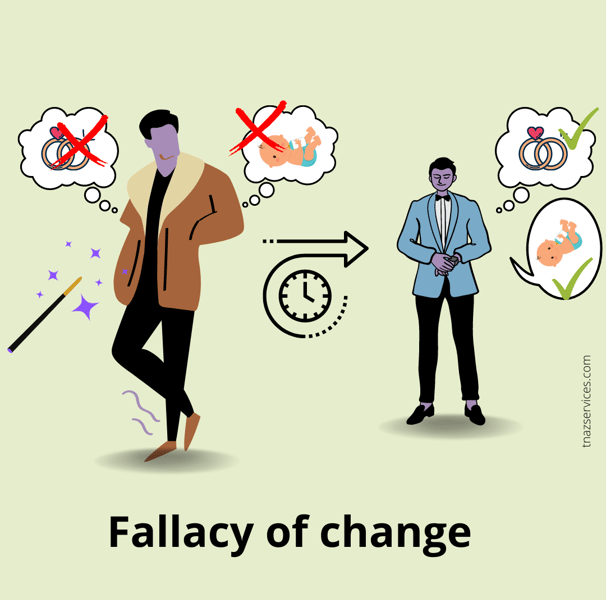

Chalenging Cogntive Distortions
Play a Quiz Game
Test your knowledge of cognitive distortions by playing a quiz-game. You play a game while you take the quiz, and each correct answer earns you points to continue. Learn more.
Take a Classic Quizz
Test your knowledge by identifying which statements are distortions.


Test your knowledge
Play a Quiz Game
Test your knowledge of cognitive distortions by playing a quiz-game. You play a game while you take the quiz, and each correct answer earns you points to continue. Learn more.
Take a Classic Quizz
Test your knowledge by identifying which statements are distortions.














